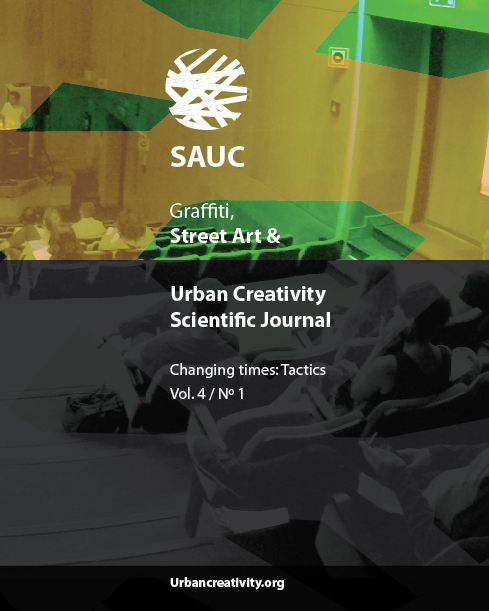With, On and Against Street Signs On Art Made out of Street Signs
DOI:
https://doi.org/10.25765/sauc.v4i1.124Palabras clave:
De Certeau, strategies, tactics, street signs, Dan Witz, Clet, Brad Dowley, DosJotasResumen
In The Practice of Everyday Life (1980), Michel de Certeau suggests the idea of a city in which there are, on one side, strategies of information, surveillance, control and infrastructure design laid out by the system and, on the other one, tactics defining the how-to-do of the users with regards to that system, that is, the operations by which they adapt them to align their own interests and needs. The texts allows us to examine the interventions of urban artists as a tactic characterized, as defined by De Certeau, as the harnessing of the system's resources (making do). This is more specifically translated into adaptability, development on a space they do not own, identification and utilization of the occasion (time) and the inventiveness of diverting time and resources (shortcut and la
perruque).
In this work, we will take traffic signs of restriction and prohibition as one of the urban components that highlight the normativization of public spaces through the direct message of "NO" (not doing). Many artists have, in previous years, developed an interest in the artistic and symbolic possibilities of these signs and have developed works (tactics) as their response to them. Dan Witz (Chicago, 1957), Clet (Bretagne, 1966), Brad Dowey (Louisville, 1980) or DosJotas (Madrid, 1982) are good examples of this.
Descargas
Estadísticas globales ℹ️
|
195
Visualizaciones
|
0
Descargas
|
|
195
Total
|
|
Descargas
Publicado
Cómo citar
Número
Sección
Licencia
Los autores/as que publiquen en esta revista aceptan las siguientes condiciones:
- Los autores/as conservan los derechos de autor.
- Los autores/as ceden a la revista el derecho de la primera publicación. La revista también posee los derechos de edición.
- Todos los contenidos publicados se regulan mediante una Licencia Atribución/Reconocimiento-SinDerivados 4.0 Internacional. Acceda a la versión informativa y texto legal de la licencia. En virtud de ello, se permite a terceros utilizar lo publicado siempre que mencionen la autoría del trabajo y a la primera publicación en esta revista. Si transforma el material, no podrá distribuir el trabajo modificado.
- Los autores/as pueden realizar otros acuerdos contractuales independientes y adicionales para la distribución no exclusiva de la versión del artículo publicado en esta revista (p. ej., incluirlo en un repositorio institucional o publicarlo en un libro) siempre que indiquen claramente que el trabajo se publicó por primera vez en esta revista.
- Se permite y recomienda a los autores/as a publicar su trabajo en Internet (por ejemplo en páginas institucionales o personales), una vez publicado en la revista y citando a la misma ya que puede conducir a intercambios productivos y a una mayor y más rápida difusión del trabajo publicado (vea The Effect of Open Access).













